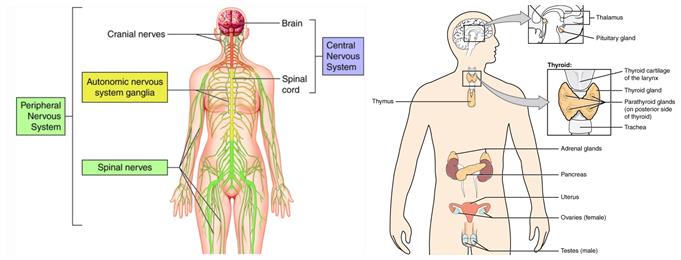
PUMPA - SMART LEARNING
எங்கள் ஆசிரியர்களுடன் 1-ஆன்-1 ஆலோசனை நேரத்தைப் பெறுங்கள். டாப்பர் ஆவதற்கு நாங்கள் பயிற்சி அளிப்போம்
Book Free DemoWe studied reflex arc and its necessity. In the absence of true thought processes, reflex arc helps the animal act quickly in a dangerous situation. But there is another system that also helps the animal in a dangerous situation called a hormonal system.

Left to right: The picture showing the divisions of the nervous system and endocrine system
For example, if a squirrel experiences a scary situation, such as an attack from its predator, it has two choices of actions. One is to fight, and another is to run away. These actions may look simple, but they require a great deal of energy in controlled ways. Many different types of tissues have to engage and integrate together to produce these actions.
If the squirrel relies on only nerve impulse, then the range of tissues require to produce the actions are very limited. Besides, if a chemical signal were to be sent through the hormonal system, it would reach all the cells of the body. In this case, a hormone named adrenaline will be secreted from the adrenal glands of the squirrel. This hormone is also secreted in humans. In a scary situation, it makes the heart beats quicker, increases the breathing rate and thus supplying our muscles with more oxygen, which will reduce the blood flow to the digestive system and skin. All of these responses work together to prepare the animal's body to deal with the event. Animal hormones are secreted by endocrine system, which is our body's second level of regulation and coordination.
The most significant distinction between the nervous system and the hormonal system are:
The nervous system sends information through neurons using electrical impulses. In contrast, the hormonal system employs chemical messengers carried through blood plasma to target cells.
- The nervous system's transmission is short-lived yet rapid, whereas the hormonal system's transmission is long-lived but takes much longer.
- Responses in the nervous system are localised, i.e., specific to a particular muscle, but responses in the hormonal system are extensive, i.e., acts upon a wide range of muscles.
- In the hormonal system, responses are often permanent, while they are transitory and reversible in the nervous system.
The endocrine system consists of the following parts or glands which helps in the production of various hormones:

Picture showing the different endocrine glands in the human being (Both female and male)
|
Gland
|
Function
|
| Hypothalamus | This region maintains homeostasis, controls the urge for eating and drinking. |
| Pineal | Melatonin, a serotonin-derived hormone that regulates sleep patterns, is produced by the pineal gland. |
| Parathyroid | This gland aids in the regulation of calcium levels in the body. |
| Thymus | It aids in developing T-cells, the adaptive immune system's function, and the maturation of the thymus. |
| Thyroid | It controls the metabolism of carbohydrates, proteins and fats |
| Adrenal | Secretes cortisol hormone and sex hormones. |
| Pituitary | The pituitary gland is often known as the body's "Master endocrine gland" or the "Chief executive of the endocrine system" because it secretes several hormones (such as TSH, ACTH, and others) that regulate the functioning of other endocrine glands. |
| Pancreas | This gland is responsible for synthesising insulin hormones, which are essential for blood sugar regulation. |
| Testes | These hormones promote muscle growth, face and axillary hair growth, aggression, low voice tone etc. |
| Ovaries | The ovary generates oestrogen and progesterone, which are steroid hormones. The oestrogen is mostly mainly secreted by the developing ovarian follicles. After ovulation, the ruptured follicle is converted to a corpus luteum, which secretes mainly progesterone |
In this topic, we will explore the glands mentioned above and their secretions with their functions in great detail.
Reference:
https://upload.wikimedia.org/wikipedia/commons/1/15/1801_The_Endocrine_System.jpg
https://upload.wikimedia.org/wikipedia/commons/7/78/Endocrine_English.svg
http://learn.neurotechedu.com/the_nervous_system/
https://upload.wikimedia.org/wikipedia/commons/7/78/Endocrine_English.svg